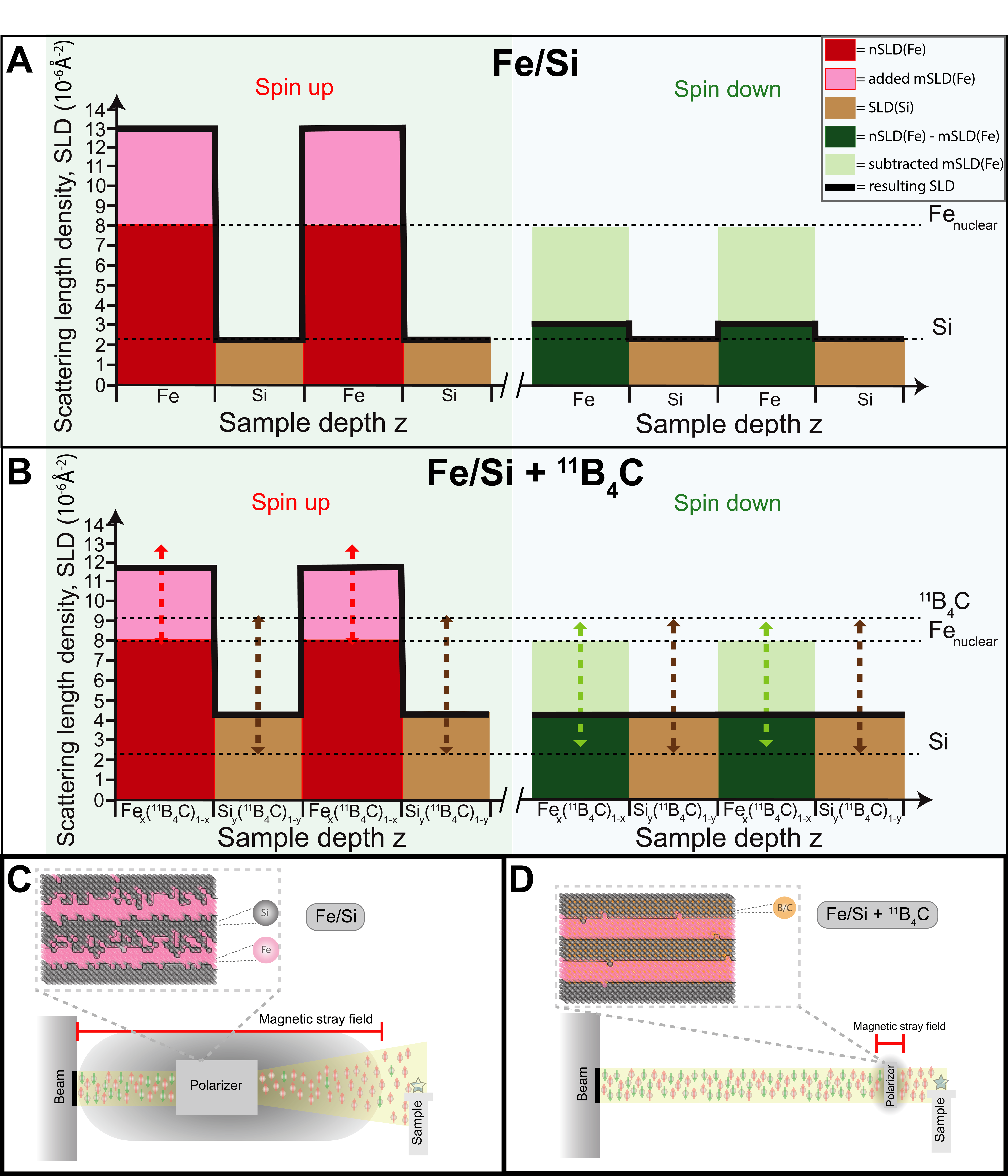Improved polarizing neutron optics with increased reflectivity, enhanced polarization, less diffuse scattering and eliminated magnetic coercivity
by Anton Zubayer
Why?
Neutron optics are essential parts of neutron scattering facilities, where they guide, collimate, focus, and polarize the neutron beam tailored to each beamlines experiments. The most common neutron optics are multilayer neutron optics which are characterized by alternating layers of materials. For polarizing neutron optics, one of the layers must be magnetic and also match the scattering length density (SLD) for spin down neutrons for the magnetic and non-magnetic layer. Current state-of-the-art polarizing material systems, such as Fe/Si encounter challenges. These include reduced reflectivity due to interface roughness and intermixing, the non-optimal polarization due to SLD mismatch between the layers for spin down neutrons, and a high background due to laterally correlated roughness. Additionally, the need of large external fields for polarizer and analyzer operation put constraints on the instrumental designs. To address these limitations, we propose a novel approach incorporating 11B4C throughout the Fe/Si multilayer structure. This resolves all the mentioned issues, offering improved reflectivity, enhanced polarization, reduced diffuse scattering, and achieving saturation of magnetization at very low fields.

Fig. 1. Concept of scattering length density (SLD) tuning and implementation of improved polarizing neutron optics. (A and B) Illustrations showing the SLD depth profiles (solid black curves) resulting from the different magnetic and nuclear SLDs for (A) Fe/Si and (B) 11B4C-containing Fe/Si multilayers. In the spin-up configuration, the magnetic SLD (mSLD) of Fe is added to the nuclear SLD (nSLD) of Fe, while in the spin-down configuration, the magnetic SLD of Fe is subtracted from the nuclear SLD of Fe. The dashed arrows in (B) represent the SLD tuning possibilities achieved by incorporating varying amounts of 11B4C. (C and D) Comparison of Fe/Si (C) with Fe/Si + 11B4C (D) highlighting the advantage of utilizing a lower applied magnetic field for polarizer saturation. This, in turn, allows for nonintrusive positioning of the polarizer closer to the sample environment, which can be achieved by incorporating 11B4C to eliminate magnetic coercivity, in other words, make the polarizer magnetically soft.
How?
Following the optimization of growth parameters, numerous multilayers of Fe/Si and Fe/Si + 11B4C were deposited with various bilayer thicknesses, number of periods, and amount of 11B4C. Once the films were synthesized, they were analyzed using X-ray diffraction to examine crystallinity changes upon the introduction of 11B4C, X-ray reflectivity was utilized to evaluate the reflective properties and interface quality. Vibrating sample magnetometry, conducted at the University of Iceland, was used to investigate the magnetic properties such as coercivity and magnetization, while transmission electron microscopy provided detailed microstructural images of the multilayer structures. Grazing incidence small-angle X-ray scattering, conducted at P03, MINAXS, PETRA III, DESY, Germany, enabled observation of diffuse scattering, and finally polarized neutron reflectivity, performed at MORPHEUS, PSI, Switzerland, served as the conclusive demonstration of reflectivity and polarization properties.
What´s next?
There are several additional considerations needed to take into account for a final assessment of the advantages of our novel approach. Presently, we are analyzing and writing manuscripts of our investigations conducted at POLREF, ISIS, UK, focusing on the magnetic off-specular scattering measurements. Additionally, we are engaged in spin-flip measurements at SuperADAM, ILL, France, examining stacked multilayers containing more than a thousand layers each. We are also interested in investigating the strain and stress on these multilayers, as well as conducting annealing experiments. Moreover, from an industrial point of view, we are exploring the possibility of establishing a spin-off company to assist manufacturers of neutron optics to implement our design in mirrors for neutron scattering facilities worldwide.
Who?
This project was realized through the collaboration of various researchers at Linköping university, with our expertise and knowledge in thin films. Magnetic measurements were conducted by our collaborators at the University of Iceland (Iceland). GISAXS measurements were performed at the synchrotron facility PETRA III (Germany), while the neutron beamtime and collaboration was extensively made with various researchers and instrument scientists at PSI (Switzerland). Financial support for the research was realized by Vetenskapsrådet (VR), the Hans Werthén Scholarship, and the Physics grant from the Royal Academy of Sciences.
Contact
Anton Zubayer
PhD student
Linköping University
anton.zubayer@liu.se
Fredrik Eriksson
Associate Professor
Linköping University
fredrik.eriksson@liu.se
Naureen Ghafoor
Associate Professor
Linköping University
naureen.ghafoor@liu.se
Jens Birch
Professor
Linköping University
jens.birch@liu.se
Anton Zubayer et al., Reflective, polarizing, and magnetically soft amorphous neutron optics with 11B-enriched B4C. Sci. Adv. 10, eadl0402 (2024). DOI: 10.1126/sciadv.adl0402